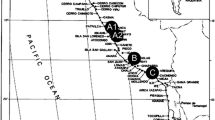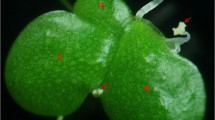Abstract
Procedures for producing seed of hybrid swedes using self-incompatibility were examined. Single-cross, double-cross and modified double-cross hybrids were compared in isolation plots using natural pollinators and in polythene tunnels using blow-flies. With good coincidence of flowering and the same flower colour, nearly 100% hybrid seed was produced by natural pollinators with the single-crosses, the double-cross and one of the two modified double-cross hybrids; the other modified double-cross hybrid produced 87%hybrid seed. With poor coincidence of flowering and different flower colours the proportion of hybrids dropped to 61%. Using different flower colours and blow-flies as pollinators in polythene tunnels, higher levels of outcrossing were produced than in isolation plots with natural pollinators; the opposite result was obtained when the same flower colour was used.
Similar content being viewed by others
References
Carter, A.L. & T. McNeilly, 1976. Increased atmospheric humidity post-pollination: A possible aid to the production of inbred line seed from mature flowers in the Brussels sprout (Brassica oleracea var. gemmifera). Euphytica 25: 531–538.
Faulkner, G.J., 1974. Factors affecting field-scale production of seed of F1 hybrid Brussels sprouts. Ann Appl Biol 77: 181–190.
Faulkner, G.J. & W.L. Hinton, 1980. F1 Hybrid Brussels sprout seed: An assessment of production methods and their economic viability. Hort Res 20: 49–59.
Free, J.B. & I.H. Williams, 1973. The pollination of hybrid kale (Brassica oleraceae L.) J Agric Sci Camb 81: 557–559.
Gemmell, D.J., J.E. Bradshaw, T. Hodgkin & S. Gowers, 1989. Self-incompatibility in Brassica napus: seed set on crossing 19 self-incompatible lines. Euphytica 42: 71–77.
Gowers, S., 1974. The production of F1 hybrid swedes (Brassica napus ssp. rapifera) by the utilisation of self-incompatibility. Euphytica 23: 205–208.
Gowers, S., 1975. Methods of producing F1 hybrid swedes (Brassica napus ssp. rapifera). Euphytica 1975: 537–541.
Gowers, S., 1986. Possible applications of self-incompatibility in the production of Brassica napus cultivars. NZ Agronomy Society Special Pub No. 5: 63-66.
MacFarlane Smith, W.H., & D.C. Newbould, 1988. The effect of covering material and nitrogen application on seed yield and quality of Brassica multiplications in seed production tunnels. Seed Sci & Technol 16: 445–455.
Martin, F.W., 1959. Staining and observing pollen tubes in the style by means of flourescence. Stain Technol 34: 125–128.
Rights and permissions
About this article
Cite this article
Gowers, S. A comparison of methods for hybrid seed production using self-incompatibility in swedes (Brassica napus ssp. napobrassica). Euphytica 113, 207–210 (2000). https://doi.org/10.1023/A:1003941606357
Issue Date:
DOI: https://doi.org/10.1023/A:1003941606357




